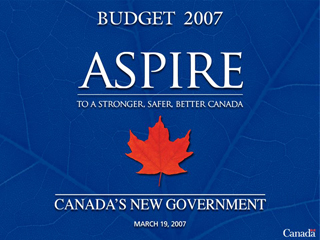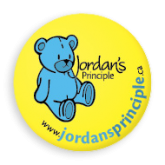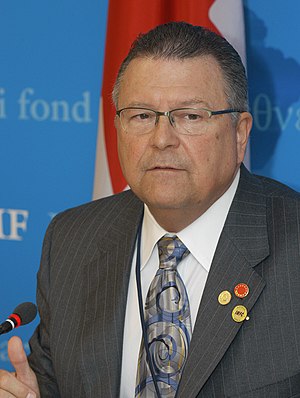
Medicare is a national health insurance program in the United States, begun in 1966 under the Social Security Administration (SSA) and now administered by the Centers for Medicare and Medicaid Services (CMS). It primarily provides health insurance for Americans aged 65 and older, but also for some younger people with disability status as determined by the SSA, and people with end stage renal disease and amyotrophic lateral sclerosis.
A registered retirement savings plan (RRSP), or retirement savings plan (RSP), is a type of financial account in Canada for holding savings and investment assets. RRSPs have various tax advantages compared to investing outside of tax-preferred accounts. They were introduced in 1957 to promote savings for retirement by employees and self-employed people.
The Canadian federal budget of 2004 was a budget for the Government of Canada. It was read in the House of Commons of Canada on March 23, 2004 by Finance Minister Ralph Goodale of the governing Liberal Party. It was prepared by Goodale with significant input from Prime Minister Paul Martin, who had previously served as Minister of Finance in the government of Jean Chrétien.

James Michael Flaherty, was a Canadian politician who served as Canada's federal Minister of Finance (2006–2014) and a provincial Minister of Finance for Ontario (2001–2002). From 1995 until 2005, he was the Member of Provincial Parliament for Whitby—Ajax, and a member of the Ontario Progressive Conservative Party caucus and unsuccessfully sought the leadership of the provincial party on two occasions.
A 529 plan is a tax-advantaged investment vehicle in the United States designed to encourage saving for the future higher education expenses of a designated beneficiary. In 2017, K–12 public, private, and religious school tuition were included as qualified expenses for 529 plans along with post-secondary education costs after passage of the Tax Cuts and Jobs Act.
A registered education savings plan (RESP) in Canada is an investment vehicle available to caregivers to save for their children's post-secondary education. The principal advantages of RESPs are the access they provide to the Canada Education Savings Grant (CESG) and as a method of generating tax-deferred income.

The Ontario Student Assistance Program (OSAP) (French: Régime d'aide financière aux étudiantes et étudiants de l'Ontario ) is a provincial financial aid program that offers grants and loans to help Ontario students pay for their post-secondary education. OSAP determines the amount of money that a student is eligible to receive by considering factors such as tuition, course load, and the financial resources of the student. More than 380,000 students – more than half of all full-time students –received student financial aid in 2014-15.
The Canada Child Tax Benefit (CCTB) was a tax-free monthly payment available to eligible Canadian families to help with the cost of raising children. The CCTB could incorporate the National Child Benefit (NCB), a monthly benefit for low-income families with children, and the Child Disability Benefit (CDB), a monthly benefit for families caring for children with severe and prolonged mental or physical disabilities.
The Balanced Budget Act of 1997,, was an omnibus legislative package enacted by the United States Congress, using the budget reconciliation process, and designed to balance the federal budget by 2002. This act was enacted during Bill Clinton's second term as president.
In the United States, federal assistance, also known as federal aid, federal benefits, or federal funds, is defined as any federal program, project, service, or activity provided by the federal government that directly assists domestic governments, organizations, or individuals in the areas of education, health, public safety, public welfare, and public works, among others.

The Canadian federal budget for the 2007–2008 fiscal year was presented to the House of Commons of Canada by Finance Minister Jim Flaherty. Flaherty presented the 2007 budget on March 19, 2007. No income tax or GST cuts were announced but there were tax credits for some families with children under 18. The federal budget included $14 billion in new spending and $5.7 billion in tax cuts. This was the second budget of the 39th Canadian Parliament.
The Canada Education Savings Grant (CESG) is part of a Government of Canada program, administered through Employment and Social Development Canada, to assist with savings for Canadian children's higher education. Under the CESG program, the government will contribute an amount to a Registered Education Savings Plan (RESP) according to a formula which is dependent on the amount contributed and the income level of the family making the contributions. As of 1 July 2005, the CESG is legislated by the Canada Education Savings Act.
Social programs in Canada include all Canadian government programs designed to give assistance to citizens outside of what the market provides. The Canadian social safety net covers a broad spectrum of programs, many of which are run by the provinces. Canada also has a wide range of government transfer payments to individuals, which totaled $176.6 billion in 2009—this cost only includes social programs that administer funds to individuals; programs such as medicare and public education are additional costs.

Higher education in Ontario includes postsecondary education and skills training regulated by the Ministry of Colleges and Universities and provided by universities, colleges of applied arts and technology, and private career colleges. The current minister is Ross Romano who was appointed in June 2019. The ministry administers laws covering 22 public universities, 24 public colleges, 17 privately funded religious universities, and over 500 private career colleges. 18 of the top 50 research universities in Canada are in Ontario.
The Canadian federal budget for the 2009-2010 fiscal year was presented to the House of Commons of Canada by Finance Minister Jim Flaherty on January 27, 2009. The federal budget included $40 billion in stimulus and $20 billion in personal income tax cuts.

Jordan's Principle is a child-first and needs-based principle used in Canada to ensure that First Nations children living on and off reserve have equitable access to all government funded public services. It holds that First Nations children should not be denied access to public services while governments fight over who should pay. In order to ensure substantive equality, this can also include services that are not ordinarily available to other children. According to the First Nations Child & Family Caring Society of Canada, the organization that hosts the Jordan's Principle campaign:
Jordan’s Principle ensures that First Nations children can access all public services when they need them. Services need to be culturally-based and take into full account the historical disadvantage linked to colonization that many First Nations children live with. The government of first contact pays for the service and resolves jurisdictional/payment disputes later.
A Registered Disability Savings Plan (RDSP) is a Government of Canada program designed to enable individuals with disabilities, with assistance from family and friends to save for their future financial security. The Government of Canada assists people to save with the Canada Disability Savings Program, consisting of the Canada Disability Savings Grant and Canada Disability Savings Bond. The Canada Disability Savings Grant matches personal contributions. The Canada Disability Savings Bond provides funding to RDSPs of people with low and moderate incomes.

The Canadian federal budget for the 2008-2009 fiscal year was presented to the House of Commons of Canada by Finance Minister Jim Flaherty on February 26, 2008.
The Canadian federal budget for fiscal year 2014–2015 was presented to the House of Commons of Canada by Jim Flaherty on 11 February 2014. This was the last budget presented by the Finance Minister before his resignation in March and death in April. At the end of the fiscal year, the government was surprised to post a budgetary surplus of $1.9 billion. This however would later be overturned to a small deficit of $550 million due to improper accounting methodologies for the Government's unfunded pension obligations, as pointed out for years by the Auditor General.

The Government of Canada introduced multiple temporary social security and financial aid programs in response to the economic impacts of the COVID-19 pandemic in Canada. The initial CA$82-billion aid package was announced on March 18, 2020 by Justin Trudeau.









